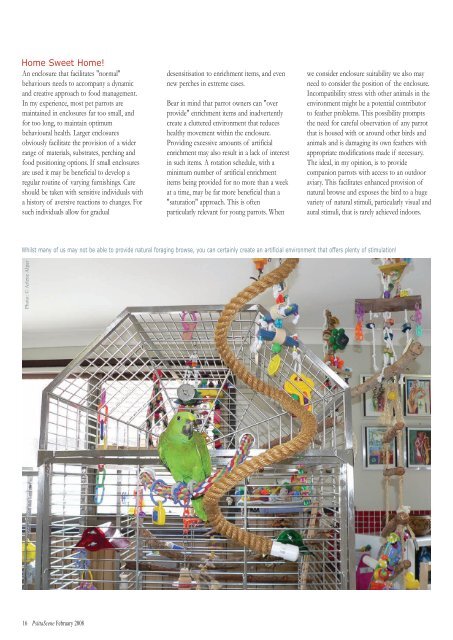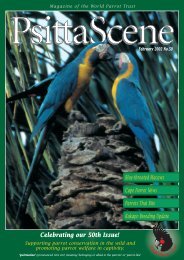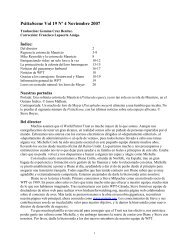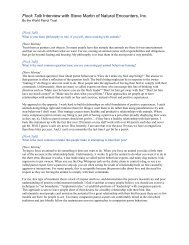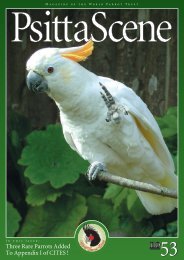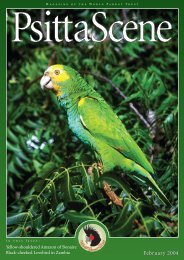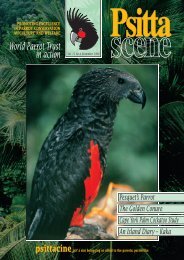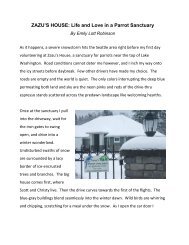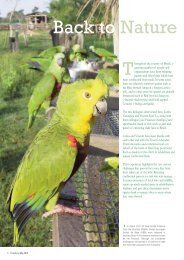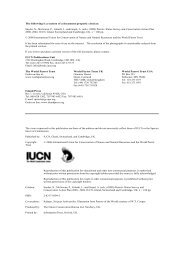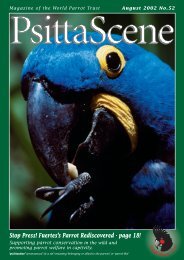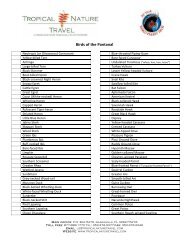PS 20 1 Feb 08.qxd - World Parrot Trust
PS 20 1 Feb 08.qxd - World Parrot Trust
PS 20 1 Feb 08.qxd - World Parrot Trust
You also want an ePaper? Increase the reach of your titles
YUMPU automatically turns print PDFs into web optimized ePapers that Google loves.
Home Sweet Home!<br />
An enclosure that facilitates "normal"<br />
behaviours needs to accompany a dynamic<br />
and creative approach to food management.<br />
In my experience, most pet parrots are<br />
maintained in enclosures far too small, and<br />
for too long, to maintain optimum<br />
behavioural health. Larger enclosures<br />
obviously facilitate the provision of a wider<br />
range of materials, substrates, perching and<br />
food positioning options. If small enclosures<br />
are used it may be beneficial to develop a<br />
regular routine of varying furnishings. Care<br />
should be taken with sensitive individuals with<br />
a history of aversive reactions to changes. For<br />
such individuals allow for gradual<br />
desensitisation to enrichment items, and even<br />
new perches in extreme cases.<br />
Bear in mind that parrot owners can "over<br />
provide" enrichment items and inadvertently<br />
create a cluttered environment that reduces<br />
healthy movement within the enclosure.<br />
Providing excessive amounts of artificial<br />
enrichment may also result in a lack of interest<br />
in such items. A rotation schedule, with a<br />
minimum number of artificial enrichment<br />
items being provided for no more than a week<br />
at a time, may be far more beneficial than a<br />
"saturation" approach. This is often<br />
particularly relevant for young parrots. When<br />
we consider enclosure suitability we also may<br />
need to consider the position of the enclosure.<br />
Incompatibility stress with other animals in the<br />
environment might be a potential contributor<br />
to feather problems. This possibility prompts<br />
the need for careful observation of any parrot<br />
that is housed with or around other birds and<br />
animals and is damaging its own feathers with<br />
appropriate modifications made if necessary.<br />
The ideal, in my opinion, is to provide<br />
companion parrots with access to an outdoor<br />
aviary. This facilitates enhanced provision of<br />
natural browse and exposes the bird to a huge<br />
variety of natural stimuli, particularly visual and<br />
aural stimuli, that is rarely achieved indoors.<br />
Whilst many of us may not be able to provide natural foraging browse, you can certainly create an artificial environment that offers plenty of stimulation!<br />
Photo: © Arlene Alpar<br />
16 PsittaScene <strong>Feb</strong>ruary <strong>20</strong>08


